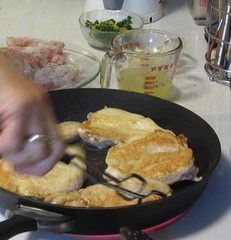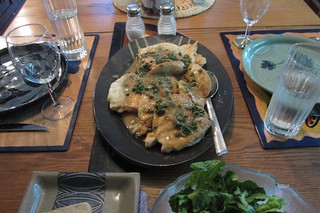Chicken Piccata for Louise's Picnic Game, 2014
Chicken Piccata is an old favorite, featured at traditional restaurants and often cooked at home, for example by my sister-in-law. Thanks to her mentioning it, I started thinking about this classic.
Served with garlic mashed potatoes, Chicken Piccata is on the menu at Merriman’s Cafe in Waikoloa on the Big Island of Hawaii where we are currently on vacation. The cafe is a spin-off of Merriman’s restaurant, one of the originators of Pacific Rim cuisine in the 1980s. Perhaps oddly, Italian/Mediterranean food is very much a part of Pacific Rim cooking. (We speculate that it's because of the longstanding Italian traditions of San Francisco, which IS on the Pacific Rim!)
Served with garlic mashed potatoes, Chicken Piccata is on the menu at Merriman’s Cafe in Waikoloa on the Big Island of Hawaii where we are currently on vacation. The cafe is a spin-off of Merriman’s restaurant, one of the originators of Pacific Rim cuisine in the 1980s. Perhaps oddly, Italian/Mediterranean food is very much a part of Pacific Rim cooking. (We speculate that it's because of the longstanding Italian traditions of San Francisco, which IS on the Pacific Rim!)
When I decided recently – a few weeks before my trip – to try making Chicken Piccata, I found a recipe on Epicurious, but I changed it in several places and especially, I simplified the cooking technique. My recipe made around 5 servings. We ate some hot from the oven with salad (shown above) and some cold with additional parsley: perfect for a picnic.
Specifically, it’s just the thing for the 2014 Picnic Game
sponsored by Louise at Months of Edible Celebrations.
To start the game, all participants have promised to go through the alphabetical list up until the letter of our own contribution, just like the old kids’ memory game. In this game, though, we link to the blog post and recipe of the other picnic goers: just click on the caption of the images for A and B below.
So here it is: I’m going on a picnic and I'm bringing:
Specifically, it’s just the thing for the 2014 Picnic Game
sponsored by Louise at Months of Edible Celebrations.
To start the game, all participants have promised to go through the alphabetical list up until the letter of our own contribution, just like the old kids’ memory game. In this game, though, we link to the blog post and recipe of the other picnic goers: just click on the caption of the images for A and B below.
So here it is: I’m going on a picnic and I'm bringing:
 |
| A -- Angel Food Cake |
Recipe
Chicken Piccata Ingredients

4 boneless chicken breast halves or equivalent amount boned
by hand – skin optional
3 tablespoons butter (less if you left some skin on the
breasts)
4 teaspoons flour to make kneaded butter
Additional flour, salt, and pepper for dredging the chicken
2 tablespoons olive oil for browning the chicken
1/3 cup dry white wine
1/4 cup fresh lemon juice plus lemon zest (Don't forget to
grate lemon zest before squeezing juice!)
1/4 cup canned chicken broth ... or use homemade stock from
the chicken bones
1/2 large shallot, chopped or sliced very thin
1/4 cup drained capers
1/4 cup chopped fresh parsley
Method


- If using whole unboned chicken breasts: remove bones and cut meat into ¾-inch-thick cutlets. Optionally, use the bones and some carrots and onion or shallots to make stock. If you remove the skin, also use it to make the stock.
- Make kneaded butter: mix 1 tablespoon of butter and 4 teaspoons of flour in small bowl until smooth.
- Preheat oven to 350 degrees. Dredge chicken cutlets at last minute in flour-salt-pepper mixture. Brown chicken in batches in a frying pan in olive oil, and put them on a cookie sheet. When all are browned, bake them in the oven until done while making sauce in the same frying pan. Baking time depends on how thick you cut them, somewhere around 15 minutes.
- In pan juices in the frying pan, brown a few slices of shallot. Add wine, lemon juice and broth to frying pan and simmer for around 5 minutes over medium-high heat with shallots and additional butter as needed. Whisk in butter-flour mixture and simmer until sauce thickens slightly, about 2 minutes. Leave on low heat until chicken is done. Add more stock if needed.
- Assemble dish. To the frying pan add the capers, parsley, lemon zest, and remaining 2 tablespoons butter (if needed). Season sauce to taste with salt and pepper. Place chicken on serving platter, pour sauce over chicken, and serve. Or place chicken breasts in storage container, pour sauce over chicken, and chill until needed, adding more freshly chopped parsley before serving.




























